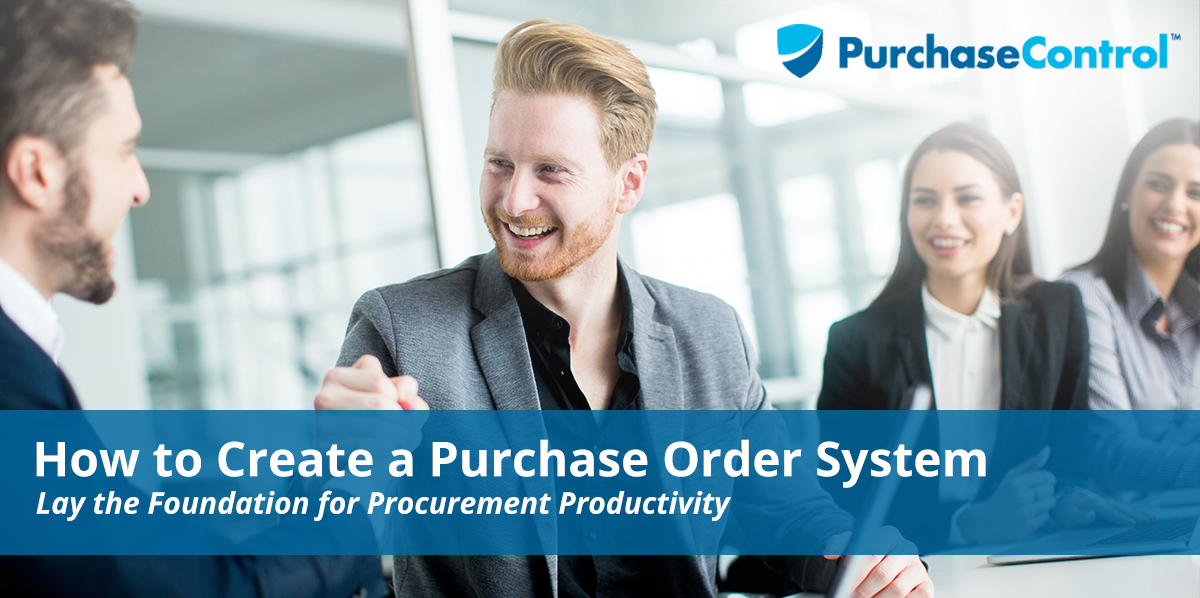Traditionally, small businesses—who may have not, in the past, had the time, resources, or need for formal business processes—have taken a rather informal approach to systems such as procurement. Wearing lots of hats and filling many roles, the average small business owner of days gone by might’ve contented themselves with handshake deals or email documentation to aid in tracking their purchases and financial health.
With technology and systems thinking becoming a critical part of successfully navigate the business world, however, purchase order management has become an essential business process whether you’re a one-person small business or part of a large procurement team. Master the basics of purchase orders, and then get ready to power up your purchasing even further with eProcurement.
Purchase Order Systems Defined
At its most basic, a purchase order system is simply an end-to-end manual (paper-based) or software-driven solution for generating, tracking, verifying, and managing purchase orders. By formalizing the purchase order process with a standardized workflow, hierarchies for ordering and approvals, and connected, cross-checked documentation, you can reduce your risk exposure, improve spend visibility, save time and money, and reduce both overhead and human error.
While it can be as simple as a set of spreadsheet, email, and calendar-based reminders, the best purchase order systems are core components of centralized procurement solutions. Automated purchase order software, supported by machine learning and artificial intelligence, help your company avoid the potentially costly redundancies and rogue spending that can cripple the growth and competitiveness of even a successful business.
That said, not every business necessarily needs “the whole enchilada” from day one. For growing small businesses, building a purchasing process, either from scratch or with the help of purchase order software, that incorporates the core concepts that make more robust procurement solutions so effective can provide outstanding value while ensuring your staff and company will be ready for a smooth transition when it’s time to upgrade to a full procurement solution.
“The larger your spend, the greater your need to track and verify orders, as well as the financial data (for audit trails, forecasting, etc.), communications (e.g. emails, approvals, etc.), and potentially valuable performance and process improvement data they generate. The first step in getting a firm grip on these variables is developing a user-friendly purchase order system.”
Key Benefits of Using a Purchase Order System
As your business expands, so too does your need for record keeping, inventory management, and a more nuanced approach to the procurement process. The larger your spend, the greater your need to track and verify orders, as well as the financial data (for audit trails, forecasting, etc.), communications (e.g. emails, approvals, etc.), and potentially valuable performance and process improvement data they generate. The first step in getting a firm grip on these variables is developing a user-friendly purchase order system.
Establishing a purchase order system can benefit your business in many important ways, including:
- Fewer Errors. The purpose of a purchase order is to create a contract between your company (the buyer) and a given vendor (the seller). By documenting, in detail, everything from terms and conditions to price, quantity, and quality of goods, a purchase order provides both peace of mind and reduced chance for errors throughout the process. Detailed information aids in project planning and budgeting, too; integrating your financial planning with your PO system lets you make smarter and more strategic spend decisions for projects of all sizes without worrying about coming up short.
In addition, connecting your purchase order number with the related invoice and shipping documents, along with all relevant communications, makes it much easier to process payment on time and create a correct and easily-navigated audit trail. Fewer errors, with more complete information about your spend, makes it easier to pursue and achieve internal process improvements, too. - Improved Inventory Management. With a purchase order system in place, you gain invaluable insight into your current inventory levels. Internal process improvement extends to inventory as well; you’ll be able to manage reorders more effectively, avoid redundant purchases, and use the insights you glean to negotiate better terms and pricing with your best vendors for frequent and large purchases.
- Better Supplier Evaluation. Some of the most important data bobbing in the stream of information generated by your spend is related to vendor performance—and it’s not just about who should be giving you discounts or better terms. With a purchase order system, you’ll have quick and easy answers to questions like, “Who is our most reliable supplier for Product X?”, “Which suppliers can we count on to cover our business needs in the event of shipping troubles/natural disasters/etc.?”, and “Which vendors could conceivably become trusted partners in a shared initiative?”
- Access to Governmental and Educational Suppliers. If you’re planning to do business with schools or government bodies, you’ll need a formal purchase order system, as many will authorize payment only for invoices connected to an official and approved purchase order.
Creating a Purchase Order System
Every great improvement has to start somewhere. You can build a purchase order system for your business manually, or with the help of purchase order software packages of various stripes and capabilities. However you approach it, though, you’ll need to follow a simple series of steps:
- Create Purchase Order Documents. You can start from scratch in your preferred word processing program, or with purchase requisition and purchase order templates. Make sure both your purchase requisitions (the requests for goods and services) and the purchase orders generated from them are as detailed and comprehensive as possible. The more information you have about each transaction, the more easily you’ll be able to track and manage orders. Data-rich POs provide quality input for financial analysis and process improvement, too.
Depending on the tools you’re using, you can add macros or other automated steps to streamline the process from the first step. For example, you might link purchase requisitions with their corresponding purchase order, automatically transferring the information without the need for separate data entry, or automatically populate a drop-down list for a given service from a database of pre-approved vendors. - Itemize the Steps in the Purchase Order Process. Automation certainly saves time, but before you can hand things over to the AI, you need to lay out the particulars for your company’s purchasing system, including order processing. Breaking the process down will also help you eliminate redundancies and potential roadblocks from the workflow before it’s automated, improving efficiency from day one.
- Create a Workflow. Once you’ve established the way your purchase order process should work, and created the documents necessary to support it, you can move forward with creating a workflow.
Ideally, your workflow will move from request to review to approval to placement, followed by receipt, review, confirmation, and finally payment. The workflow will have different roles and responsibilities, as dictated by the stakeholders involved at each step. Requesters will perform data entry, for example, while financial and management staff will perform review and approval tasks. - Use Hierarchies to Establish Roles, Responsibilities, and Levels of Access. The human beings using your workflow and documents will need to know what they’re responsible for, and when (e.g., review, approval, submission of formal PO, etc.). They’ll also need access to different levels of information, automatic reminders to reduce delays and logjams in the approval workflow, and an easy way to collaborate in real-time. This will further eliminate redundancy and errors.
- Do a “Dry Run” with Your Procurement Team. Before you debut your new purchase order system to the company-wide, do a test run with a team from all levels of the hierarchy to ensure it works as intended. That way, you can address any hiccoughs in the microcosm instead of dealing with myriad questions and/or complaints.
- Deploy the New PO System. Update your processes. Schedule training to teach every staff member who needs to use the system on how it works, their roles and responsibilities, and, most importantly, where they can get help if needed. Collect as much data as possible, and be ready to address concerns as they crop up.
- Solicit Feedback and Refine Your Processes. Once your new purchase order system has been activated and used by your staff, get their input on what works, what doesn’t, and what they’d like to see added. This meta-data, touching on user experience, can help you tweak your process to make it more effective, less time-consuming, and more accurate.
Keep in mind that every step of this process is ultimately much easier and more efficient with the help of procurement software. Even small businesses can save time and money with the help of cost-effective automation; the less time you spend processing purchase orders, the more time, money, and resources you have for growing your business.
Make Purchase Orders Part of Your Procurement Plan
It’s a simple document, but every purchase order plays an important role in your business’ success. Harness the power of the purchase order to slash invisible spend, free your staff from redundancies and error-chasing, and streamline your internal processes for maximum efficiency with minimal headaches. Take control of your purchase orders, and lay the foundation for strong, effective procurement that feeds your company’s productivity and profits.
Take the Pain out of Purchase Orders With PurchaseControl's Automation.
Find Out How








